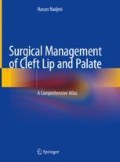Abstract
The goals for treating the patient with a cleft palate are to achieve normal speech, hearing, and maxillofacial growth and to avoid fistulas. Palatal muscle reconstruction in cleft palate patients confers better functional results with respect to velopharyngeal competence and eustachian tube function. Although most children with cleft palates eventually recover normal eustachian tube function after palatoplasty, for the majority of children, this recovery does not occur for many years. The author does strongly believe that proper palatal muscle repair is of paramount importance for a good surgical outcome after cleft palate repair. We hypothesized that the preservation of the innervation and vascularization of the palatal muscles during their dissection, reorientation, and suturing might optimize eustachian tube function. Surgical robots provide three-dimensional endoscopic vision, which gives the surgeon true depth perception. This vision provides increased freedom of motion for the micro-endoscopic instruments, including simulated flexion, extension, pronation, and supination of the instruments. The aforementioned advantages facilitate more delicate handling of soft tissues and increased surgical precision.
Access this chapter
Tax calculation will be finalised at checkout
Purchases are for personal use only
References
Smith TL, DiRuggiero DC, Jones KR. Recovery of eustachian tube function and hearing outcome in patients with cleft palate. Otolaryngol Head Neck Surg. 1994;111(4):423–9.
Nadjmi N, Van Erum R, De Bodt M, Bronkhorst EM. Two-stage palatoplasty using a modified Furlow procedure. Int J Oral Maxillofac Surg. 2013;42(5):551–8.
Hockstein NG, Nolan JP, O’Malley BW Jr, Woo YJ. Robot-assisted pharyngeal and laryngeal microsurgery: results of robotic cadaver dissections. Laryngoscope. 2005;115(6):1003–8.
Hockstein NG, O’Malley BW Jr, Weinstein GS. Assessment of intraoperative safety in transoral robotic surgery. Laryngoscope. 2006;116(2):165–8.
O’Malley BW Jr, Weinstein GS, Hockstein NG. Transoral robotic surgery (TORS): glottic microsurgery in a canine model. J Voice. 2006;20(2):263–8.
O’Malley BW Jr, Weinstein GS. Robotic skull base surgery: preclinical investigations to human clinical application. Arch Otolaryngol Head Neck Surg. 2007;133(12):1215–9.
Weinstein GS, O’Malley BW Jr, Snyder W, Hockstein NG. Transoral robotic surgery: supraglottic partial laryngectomy. Ann Otol Rhinol Laryngol. 2007;116(1):19–23.
Nadjmi N. Transoral robotic cleft palate surgery. Cleft Palate Craniofac J. 2016;53(3):326–31. https://doi.org/10.1597/14-077. Epub 2015 Jun 29.
Smartt JM Jr, Gerety P, Serletti JM, Taylor JA. Application of a robotic telemanipulator to perform posterior pharyngeal flap surgery: a feasibility study. Plast Reconstr Surg. 2013;131(4):841–5.
Cutting C, Rosenbaum J, Rovati L. The technique of muscle repair in soft palate. Oper Techniq Plastic Reconstruct Surg. 1995;2:215–22.
Sommerlad BC, Henley M, Birch M, Harland K, Moiemen N, Boorman JG. Cleft palate re-repair—a clinical and radiographic study of 32 consecutive cases. Br J Plast Surg. 1994;47(6):406–10.
Sommerlad BC. A technique for cleft palate repair. Plast Reconstr Surg. 2003;112(6):1542–8.
Haus BM, Kambham N, Le D, Moll FM, Gourin C, Terris DJ. Surgical robotic applications in otolaryngology. Laryngoscope. 2003;113(7):1139–44.
Lobe TE, Wright SK, Irish MS. Novel uses of surgical robotics in head and neck surgery. J Laparoendosc Adv Surg Tech A. 2005;15(6):647–52.
Miyano G, Lobe TE, Wright SK. Bilateral transaxillary endoscopic total thyroidectomy. J Pediatr Surg. 2008;43(2):299–303.
Rahbar R, Ferrari LR, Borer JG, Peters CA. Robotic surgery in the pediatric airway: application and safety. Arch Otolaryngol Head Neck Surg. 2007;133(1):46–50.
Author information
Authors and Affiliations
Rights and permissions
Copyright information
© 2018 Springer International Publishing AG, part of Springer Nature
About this chapter
Cite this chapter
Nadjmi, N. (2018). Robotic-Assisted Transoral Cleft Palate Surgery (TORCS). In: Surgical Management of Cleft Lip and Palate. Springer, Cham. https://doi.org/10.1007/978-3-319-91686-6_5
Download citation
DOI: https://doi.org/10.1007/978-3-319-91686-6_5
Published:
Publisher Name: Springer, Cham
Print ISBN: 978-3-319-91685-9
Online ISBN: 978-3-319-91686-6
eBook Packages: MedicineMedicine (R0)

